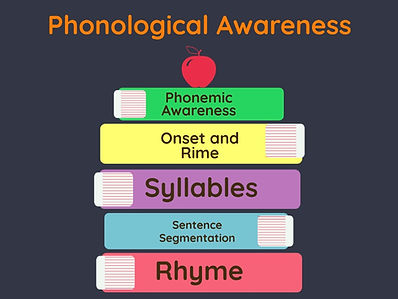PHONEMIC AWARENESS PRE & POST TEST
-
Post Test -This is to be taken after going through the material on this page. Phonological Awareness Post-Test

Phonological and Phonemic Awareness is the foundation upon which all other layers of literacy are built. Unless it is solid, the other layers will most definitely suffer, and the student will struggle to read.
PHONOLOGICAL AND PHONEMIC AWARENESS
Phonological & Phonemic Awareness
Phonological awareness is a critical early literacy skill that helps kids recognize and work with the sounds of spoken language.
Phonological awareness is made up of a group of skills. Examples include being able to identify words that rhyme, counting the number of syllables in a name, recognizing alliteration, segmenting a sentence into words, and identifying the syllables in a word. The most sophisticated — and last to develop — is called phonemic awareness.
Phonemic awareness is the ability to notice, think about, and work with the individual sounds (phonemes) in spoken words. Manipulating the sounds in words includes bending, stretching, or otherwise changing words. Children can demonstrate phonemic awareness in several ways, including:
-
recognizing which words in a set of words begin with the same sound
("Bell, bike, and boy all have /b/ at the beginning.")
-
isolating and saying the first or last sound in a word
("The beginning sound of dog is /d/." "The ending sound of sit is /t/.")
-
combining, or blending the separate sounds in a word to say the word
("/m/, /a/, /p/ – map.")
-
breaking, or segmenting a word into its separate sounds
("up – /u/, /p/.")
(The following information was retrieved from Reading Rockets: Phonological and Phonemic Awareness)

PHONEMES VS. LETTERS
English is an alphabetic language. We only have 26 letters, but there are 44 speech sounds (phonemes). Therefore, letters need to pair up to be able to make all these sounds.
Example: Three
Letters = 5 letters <t> <h> <r> <e> <e>
Sounds (phonemes) = 3 sounds /th/ /r/ /ee/


THE TOLMAN HOURGLASS
Leaders and Learning in Literacy
Teachers, here you will find one of the longer videos on this website. Dr. Tolman's Hourglass is a wonderful representation to aid in understanding the stages of phonological awareness. This video is well worth the time!
The process starts at the top of the hourglass (large) with syllables, alliteration, and onset-rime. Then, it proceeds downward (smaller) to phoneme blending and phoneme segmentation. The phonological awareness section ends in the middle of the hourglass (smallest area) with phoneme deletion substitution and reversal.
The second part (bottom half) of the hourglass focuses on orthography. Orthography is the opposite of phonological awareness in that it starts small and gets bigger, moving from graphemes to etymology.
EXAMPLES OF PHONOLOGICAL AWARENESS ACTIVITIES
COUNTING WORDS IN SENTENCES
Activity:
|The| |cat| |is| |fat.|
The teacher orally says the sentence while pulling down a block for each word.
SYLLABLE
A syllable is a unit of speech that is organized around a vowel sound.
Activity: The teacher can tap their arm as they say each syllable.
can - dy
an - i - mal
bi - cy - cle
ALLITERATION
The repetition of initial sounds in two or more words or syllables.
Activity:
Teacher says: "Peter Piper picked a peck of pickled peppers."
Teacher says: "Class can you help me make up a silly sentence with /w/ words? "Wolly wombat went ...."
ONSET AND RIME
In a syllable, the onset is the sound(s) that comes before the vowel. The rime is the vowel and everything that follows.
Activity:
The teacher can have the students orally blend the onset and rime together.
b + ag
t + ag
fl + ag
PHONEME
A phoneme is the smallest unit of sound.
Activities:
Phoneme Segmentation: Let's say all the sounds in the word cat - /c/ /a/ /t/ The teacher can pull down a tile for each phoneme sound.
Phoneme Blending: The teacher can say the sounds in words, and the students can blend them together and say the word.
/s/ /w/ /i/ /m/ = swim
Phoneme Deletion: The teacher can say a word and then tell students to delete a sound.
The teacher says: Class say the word "bat." Now say the word "bat" without the /b/.
Students say "at."
Phoneme substitution: The teacher says the word "cat." The class repeats the word "cat." The teacher then says, "change /c/ to /b/."
The class says: "bat."
_ed.jpg)